Blind-Spot Collision Warning malfunction and limitations
Blind-Spot Collision Warning malfunction
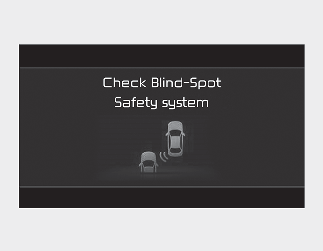
When Blind-Spot Collision Warning is not working properly, the ‘Check Blind-Spot Safety system’ warning message will appear on the cluster, and the function will turn off automatically, or the function will be limited. In this case, have your vehicle inspected by an authorized Kia dealer.
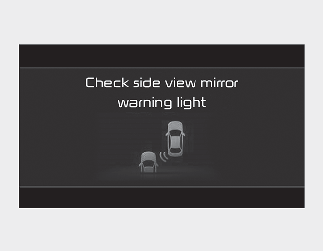
When the side view mirror warning light is not working properly, the ‘Check side view mirror warning light’ warning message will appear on the cluster. In this case, have your vehicle inspected by an authorized Kia dealer.
Blind-Spot Collision Warning disabled

When the rear bumper around the rear corner radar or sensor is covered with foreign material, such as snow or rain, or installing a trailer or carrier, it can reduce the detecting performance and temporarily limit or disable Blind-Spot Collision Warning.
If this occurs, the ‘Blind-Spot Safety system disabled. Radar blocked’ warning message will appear on the cluster.
Blind-Spot Collision Warning will operate properly when such foreign material or trailer, etc. is removed, and then the engine is restarted.
If Blind-Spot Collision Warning does not operate properly after it is removed, have your vehicle inspected by an authorized Kia dealer.

-
Even though the warning message does not appear on the cluster, Blind-Spot Collision Warning may not properly operate.
-
Blind-Spot Collision Warning may not properly operate in an area (for example, open terrain), where any objects are not detected right after the engine is turned on, or when the detecting sensor is blocked with foreign material right after the engine is turned on.

Turn off Blind-Spot Collision Warning to install a trailer, carrier, etc., or remove the trailer, carrier, etc. to use Blind-Spot Collision Warning.
Limitations of Blind-Spot Collision Warning
Blind-Spot Collision Warning may not operate properly or it may operate unexpectedly under the following circumstances:
-
There is inclement weather, such as heavy snow, heavy rain, etc.
-
The rear corner radar is covered with snow, rain, dirt, etc.
-
The temperature around the rear corner radar is high or low
-
Driving on a highway (or motorway) ramp
-
The road pavement (or the peripheral ground) abnormally contains metallic components (for example, possibly due to subway construction).
-
There is a fixed object near the vehicle, such as sound barriers, guardrails, central dividers, entry barriers, street lamps, signs, tunnels, walls, etc. (including double structures)
-
Driving in vast areas where there are few vehicles or structures (for example, desert, meadow, suburb, etc.)Driving through a narrow road where trees or grass are overgrown
-
Driving on a wet road surface, such as a puddle on the road
-
The other vehicle drives very close behind your vehicle, or the other vehicle passes by your vehicle in close proximity
-
The speed of the other vehicle is very fast that it passes by your vehicle in a short time
-
Your vehicle passes by the other vehicle
-
Your vehicle changes lanes
-
Your vehicle has started at the same time as the vehicle next to you and has accelerated
-
The vehicle in the next lane moves two lanes away from you, or when the vehicle two lanes away moves to the next lane from you
-
A trailer or carrier is installed around the rear corner radar
-
The bumper around the rear corner radar is covered with objects, such as a bumper sticker, bumper guard, bike rack, etc.
-
The bumper around the rear corner radar is impacted, damaged or the radar is out of position
-
Your vehicle height is abnormally low or high due to heavy loads, abnormal tire pressure, etc.
Blind-Spot Collision Warning may not operate properly or it may operate unexpectedly when the following objects are detected:
-
A motorcycle or bicycle
-
A vehicle such as a flat trailer
-
A big vehicle such as a bus or truck
-
A moving obstacle such as a pedestrian, animal, shopping cart or a baby stroller
-
A vehicle with low height such as a sports car

-
Driving on a curved road
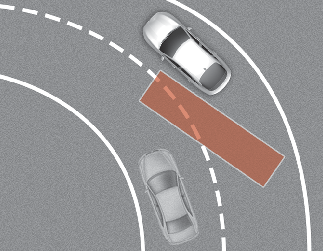
Blind-Spot Collision Warning may not operate properly when driving on a curved road. The function may not detect the vehicle in the next lane.
Always pay attention to road and driving conditions while driving.
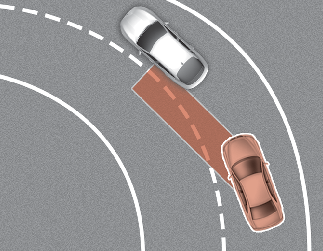
Blind-Spot Collision Warning may not operate properly when driving on the curved road. The function may recognize the vehicle in the same lane.
Always pay attention to road and driving conditions while driving.
-
Driving where the road is merging/ dividing
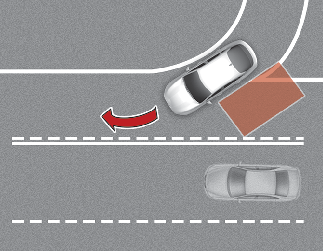
Blind-Spot Collision Warning may not operate properly when driving where the road merges or divides. The function may not detect the vehicle in the next lane.
Always pay attention to road and driving conditions while driving.
-
Driving on a sloped road
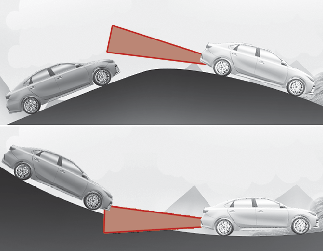
Blind-Spot Collision Warning may not operate properly when driving on a sloped road. The function may not detect the vehicle in the next lane or may incorrectly detect the ground or structure.
Always pay attention to road and driving conditions while driving.
-
Driving where the heights of the lanes are different
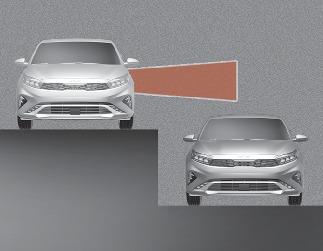
Blind-Spot Collision Warning may not operate properly when driving where the heights of the lanes are different. The function may not detect the vehicle on a road with different lane heights (underpass joining section, grade separated intersections, etc.).
Always pay attention to road and driving conditions while driving.

Blind-Spot Collision Warning may not operate properly if interfered with by strong electromagnetic waves.
Blind-Spot Collision Warning may not operate for 3 seconds after the vehicle is started, or the rear corner radars are initialized.
This device complies with Part 15 of the FCC rules.
-
This device may not cause harmful interference, and
-
This device must accept any interference received, including interference that may cause undesired operation.
-
Changes or modifications not expressly approved by the party responsible for compliance could void the user's authority to operate the device.
Radio frequency radiation exposure information:
This equipment complies with FCC radiation exposure limits set forth for an uncontrolled environment.
This equipment should be installed and operated with minimum distance of 8 in (20 cm) between the radiator and your body.
This transmitter must not be co-located or operating in conjunction with any other antenna or transmitter.